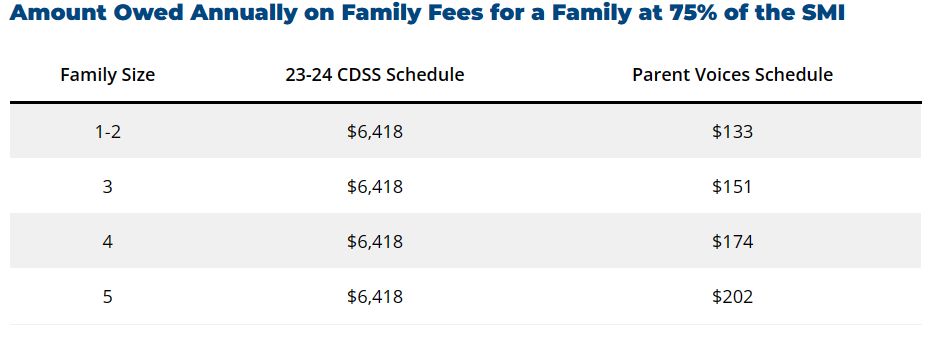July 2023 | By Laura Pryor, Erik Saucedo, and Parent Voices
A special thank you to the California Budget and Policy Center for Collaborating with Parent Voices to bring this report to completion. We could not have done this without your wonderful and experienced guidance and support. Please see their site for a link to print the report by clicking here.
Lea esta publicacion en espano
KEY TAKEAWAY
With the leadership of Parent Voices’ efforts, families will have a more equitable family fee schedule that minimizes tradeoffs between paying for child care and other essentials. Starting October 1, 2023, families below 75% of the state median income (SMI) will no longer pay a family fee, and fees will be capped at 1% for families at 75% or over the SMI.
Affordable and nurturing child care is essential for supporting California’s families. While federal relief dollars provided one-time funding to support California’s child care system during COVID-19, this funding is not ongoing, and many families will soon face the reality of higher costs for child care. This is particularly consequential for women of color who were far more likely to experience the economic effects of the COVID-19 recession.
According to data collected in 2020, Latinx, Black, and most other women of color were far more likely to live in households that were behind on their rent or mortgage payment and in households struggling to afford enough food. During this time, the state suspended the requirement for families participating in the state child care subsidy program to pay any fees associated with child care, otherwise known as “family fees.” This suspension expires on September 30, 2023.
However, with the leadership of Parent Voices’ organizing and advocacy efforts (as further detailed below), starting October 1, 2023, families will have a more equitable family fee schedule that minimizes tradeoffs between paying for child care and other basic needs. State leaders now have the opportunity to adopt a family fee schedule that truly minimizes economic challenges already faced by many California families.
About Family Fees
Family fees vary depending on a family’s income. A family earning up to 85% of the state median income (SMI) qualifies for the state subsidized child care program.1 A family fee amount for both full-day and part-day care is associated with income levels up to 85% SMI. These families must pay an income-based family fee to access subsidized full-day or part-day care.
The California Department of Social Services (CDSS) sets the fee amounts for each income level in a “family fee schedule” each fiscal year. These fees have been unaffordable for low to moderate income California families, forcing them to make hard choices between paying for child care and other basic needs such as food and housing.
However, the 2023-24 Budget Act permanently revised the family fee schedule to make these payments more affordable. Specifically, starting October 1, 2023, families below 75% of the SMI will no longer pay a family fee, and fees will be capped at 1% for families at 75% or over the SMI. The table below shows a family’s annual income at 75% of the SMI.2
Annual Income at 75% of the SMI

Moreover, outstanding fees prior to October 1, 2023 will be waived. While the 2023-24 Budget Act reflects Parent Voices’ main family fee reform points (as detailed below), the specific family fee schedule reflecting these points has yet to be confirmed.
Toward a More Equitable Family Fee Schedule

Since 2019, Parent Voices’ parent leaders have voiced their frustrations and concerns about the high price of family fees. They pointed to the schedule’s confusing formatting and how high family fees limited what was possible for their families. Parent leaders learned that other states have more affordable family fee schedules that are easier to understand.
Namely, parent leaders drew inspiration from South Dakota’s family fee schedule which capped payments at 1% of a family’s income, as well as Washington state’s schedule which had an easy-to-understand format. What emerged from this research and conversations was a clear vision for improvements to California’s family fee schedule, including:
- Removing family fees for all families up to 75% of the SMI.
- For families at 75% of the SMI or higher, paying fees on an equitable sliding scale capped at 1% of their income.
- Simplifying the family fee schedule so that key income levels are grouped together.
- Stopping the collection of delinquent family fees.
Parent Voices, with the support of the Child Care Resource Center and Every Child California, translated this dream into a concrete family fee schedule that would allow families to minimize the tradeoffs they often make between child care and basic needs. The family fee schedule proposed by Parent Voices is endorsed by their parent leaders and reflects substantial savings from the original CDSS 2023-24 family fee schedule.
Expanding Opportunities with a New Family Fee Schedule
The table below shows how much of a family’s income must be spent on family fees under the CDSS 2023-24 fee schedule and under Parent Voices’ proposed schedule for a single parent with one child.
With the Parent Voices family fee schedule, in some cases, families would recoup over nearly 10% of their annual income. The chart below shows the amount of money California families of two would save from using the Parent Voices family fee schedule. The table that follows shows the amount owed in family fees at 75% of the SMI for various-sized households.

Based on prior year enrollment numbers, using the current CDSS family fee schedule, families would collectively pay over $100 million in families fees over the course of the year. The 2023-24 Budget Act will create a significant reduction in the amount of family fees, and state leaders will act in the coming months to solidify a revised family fee scale to determine exactly how much this reduction will be.
Parent leaders shared what this reclaimed income could make possible for their families:
Karina From Sonoma County
- Karina from Sonoma County is a mother of three children. She is currently studying to get her bachelor’s degree in sociology from Sonoma State. Using the CDSS 2023-24 family fee schedule, Karina would have to pay $600 per month for child care. She shared: “When I was told that I might have to pay $600 a month because the family fee would start again in October, I was so worried. I saw my education dreams slip away. I would have to reduce my classes and it would take me longer to begin working.” Additionally, Karina shared that having to pay family fees will mean making impossible choices: “If I have to pay $600, I’m going to have to choose to take my daughter out of the program that helps her so much, or keep her in and take it out of our food budget. Feeding three growing kids and two adults is not cheap. I don’t want to go back to opening the fridge and seeing empty shelves.” Using the Parent Voices family fee schedule, Karina would save $6,766 per year. With this money, Karina can buy nearly ten months of groceries, keep her daughter in child care, and continue pursuing her educational goals.
Stevie From Fresno County
- Stevie from Fresno County is a mother of three children. She is currently working toward obtaining her Professional in Human Resources certification. Having access to child care was instrumental to her ability to graduate high school and pursue her professional goals. Using the CDSS 2023-24 family fee schedule, Stevie would have to pay $500 per month for child care. She shared: “As a single mother, sharing a room with one child, more than 50% of my net income is set aside each check to cover this expense. When the family fees come back on October 1, I will have to pay a fee of over $500 a month. This would be an extreme setback for us.” Without this family fee expense, Stevie can imagine a life where her children can participate in extracurricular activities and she can reach her dream of becoming a first-generation college graduate. The prospect of paying a family fee leaves Stevie with a number of anxiety-provoking questions: “Will I be short on rent? Will I have enough to cover the cost of gas and groceries until my next check? How am I going to make ends meet when the expenses are just the basics of simply living?” Using the Parent Voices family fee schedule, Stevie will save $6,000 per year. With this money, Stevie can afford nearly five months of groceries and two months of rent.
Elizabeth From Riverside County
- Elizabeth from Riverside County is a mother of three children. She receives a subsidy for her two-year-old son’s child care program. Using the CDSS 2023-24 family fee schedule, Elizabeth would have to pay $413 per month, on top of the $272 per month she currently pays her provider. The additional $413 per month will force Elizabeth to cut back in other areas of her basic needs budget and even consider quitting her job: “I cry when I think about what I will have to cut off our budget to pay for subsidized daycare. Will I cut off our grocery budget, gas, clothing, or utilities? I almost think about quitting my job at times because of these fees.” Using the Parent Voices family fee schedule, Elizabeth will save $4,968 per year. With this money, Elizabeth will not only be able to keep her child with his child care provider, but she can also afford 14 weeks of groceries and seven months of gas and electricity bill payments.

As state leaders decide on the new 2023-24 family fee schedule, Parent Voices’ proposed family fee schedule provides a model to ensure that families – particularly those headed by women of color like Elizabeth, Stevie, and Karina – have the income needed to pay for basic needs such as rent, utilities, and groceries, to open up possibilities for achieving their professional and educational goals and provide an enriching life for their children.
^1Families earning up to 100% of the state median income qualify for the California State Preschool Program.
^2SMI estimates are based off of the 2021 American Community Survey.

